週あたりのセット数と筋力増強の関係を調べたメタアナリシスについてはリハビリmemoで庵野拓将さんが簡潔に報告されているが,その論文の要約の翻訳を試みた.例によって Google 翻訳に頼り,おかしな訳は手動で訂正した.職場で筋トレに関して口演する機会があり,そのベースとなる論文の一部である.
Abstract
BACKGROUND:
Strength training set organisation and its relationship to the development of muscular strength have yet to be clearly defined. Current meta-analytical research suggests that different population groups have distinctive muscular adaptations, primarily due to the prescription of the strength training set dose.
筋力トレーニングのセット構成およびそれとの筋力の発達との関係は,まだ明確に定義されていない.このメタアナリシス研究は,異なる人口集団が特有の筋肉適応を有することを示唆しており,それは主に筋力トレーニングのセット数の処方による.
OBJECTIVES:
We conducted a meta-analysis with restrictive inclusion criteria and examined the potential effects of low (LWS) , medium (MWS) or high weekly set (HWS) strength training on muscular strength per exercise. Secondly, we examined strength gain variations when performing multi-joint or isolation exercises, and probed for a potential relationship between weekly set number and stage of subjects’ training (trained versus untrained) .
我々は,限定的な包含基準を用いたメタ解析を行い,低セット群 (LWS), 中セット群 (MWS) または高セット群 (HWS) の筋力トレーニングが運動ごとの筋力に及ぼす潜在的影響を調べた.第 2 に,多関節または単関節運動を行う際の筋力増強の変動を調べ,週単位のセット数と被験者の訓練段階(訓練群 vs 非訓練群)との間の潜在的な関係を調べた.
METHODS:
Computerised searches were performed on PubMed, MEDLINE, SWETSWISE, EMBASE and SPORTDiscus™ using the terms ‘strength training’, ‘resistance training’, ‘single sets’, ‘multiple sets’ and ‘volume’. As of September 2016, 6962 potentially relevant studies were identified. After review, nine studies were deemed eligible per pre-set inclusion criteria. Primary data were pooled using a random-effect model. Outcomes for strength gain, strength gain with multi-joint and isolation exercise were analysed for main effects. Sensitivity analyses were calculated for several subgroups by separating the data set and by calculation of separate analyses for each subgroup. Heterogeneity between studies was assessed using the Cochran Q and I 2 statistics.
コンピュータ検索を PubMed, MEDLINE, SWETSWISE, EMBASE および SPORTDiscus™ に対して実施し,検索語句は ‘strength training’, ‘resistance training’, ‘single sets’, ‘multiple sets’ および ‘volume’ とした.2016 年 9 月現在,6962 件の潜在的に関連性のある研究が特定された.検討の後,9 つの研究が,事前に設定された包含基準に従って適格とみなされた.一次データは,ランダム効果モデルを用いてプールされた.筋力増強,多関節および単関節運動による筋力増強の結果を主効果について分析した.データセットを分離し,各サブグループについて別々の分析を計算することによって,いくつかのサブグループについて感度分析を計算した.研究間の異質性は,Cochran Q および I2 統計を用いて評価した.
RESULTS:
Pre-versus post-training strength analysis comprised 61 treatment groups from nine studies. For combined multi-joint and isolation exercises, pre-versus post-training strength gains were greater with HWS compared with LWS [mean effect size (ES) 0.18; 95% CI 0.06-0.30; p = 0.003]. The mean ES for LWS was 0.82 (95% CI 0.47-1.17) . The mean ES for HWS was 1.01 (95% CI 0.70-1.32) . Separate analysis of the effects of pre- versus post-training strength for LWS or MWS observed marginally greater strength gains with MWS compared with LWS (ES 0.15; 95% CI 0.01-0.30; p = 0.04) . The mean ES for LWS was 0.83 (95% CI 0.53-1.13) . The mean ES for MWS was 0.98 (95% CI 0.62-1.34) . For multi-joint exercises, greater strength gains were observed with HWS compared with LWS (ES 0.18; 95% CI 0.01-0.34; p = 0.04) . The mean ES for LWS was 0.81 (95% CI 0.65-0.97) . The mean ES for HWS was 1.00 (95% CI 0.77-1.23) . For isolation exercises, greater strength gains were observed with HWS compared with LWS (ES 0.23; 95% CI 0.06-0.40; p = 0.008) . The mean ES for LWS was 0.95 (95% CI 0.30-1.60) . The mean ES for HWS was 1.10 (95% CI 0.26-1.94) . For multi-joint and isolation exercise-specific one repetition maximum (1 RM) , marginally greater strength gains were observed with HWS compared with LWS (ES 0.14; 95% CI -0.01 to 0.29; p = 0.06) . The mean ES for LWS was 0.80 (95% CI 0.47-1.13) . The mean ES for HWS was 0.97 (95% CI 0.68-1.26) .
訓練前と訓練後の強度分析は,9 つの研究から 61 の治療群を含んでいた.多関節および単関節運動を組み合わせた場合,低セット群 [平均効果量 (ES) 0.18]と比較して,訓練前と訓練後の強度の増加が高セット群で大きかった [95%CI 0.06-0.30; p = 0.003]. 低セット群の平均効果量は 0.82 (95%CI 0.47-1.17) であった.高セット群の平均効果量は 1.01 (95%CI 0.70-1.32) であった.低セット群または中セット群に対するトレーニング前後の効果の別々の分析は,低セット群 (ES 0.15; 95%CI 0.01-0.30; p = 0.04) と比較して,中セット群でわずかな強度増加を観察した.低セット群の平均効果量は 0.83 (95%CI 0.53-1.13) であった.中セット群の平均効果量 は 0.98 (95%CI 0.62-1.34) であった.多関節トレーニングでは,低セット群と比較して高セット群でより大きな強度の増加が観察された (ES 0.18; 95%CI 0.01-0.34; p = 0.04). 低セット群の平均効果量は 0.81 (95%CI 0.65-0.97) であった.高セット群の平均効果量は 1.00 (95%CI 0.77-1.23) であった.単関節トレーニングでは,低セット群と比較して高セット群でより大きな強度の増加が観察された (ES 0.23; 95%CI 0.06-0.40; p = 0.008). 低セット群の平均効果量は0.95 (95%CI 0.30-1.60) であった.高セット群の平均効果量は 1.10 (95%CI 0.26-1.94) であった.多関節および単関節運動に特有の 1 回の反復最大値 (1RM) の場合,低セット群と比較して高セット群ではわずかに大きな強度増加が観察された (ES 0.14; 95%CI -0.01~0.29; p = 0.06). 低セット群の平均効果量は 0.80 (95%CI 0.47-1.13) であった.高セット群の平均効果量は 0.97 (95%CI 0.68-1.26) であった.
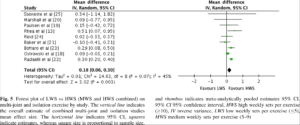
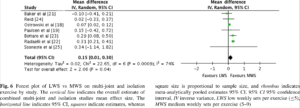
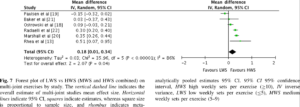
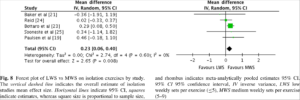
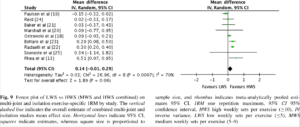
CONCLUSION:
This meta-analysis presents additional evidence regarding a graded dose-response relationship between weekly sets performed and strength gain. The use of MWS and HWS was more effective than LWS, with LWS producing the smallest pre- to post-training strength difference. For novice and intermediate male trainees, the findings suggest that LWSs do not lead to strength gains compared with MWS or HWS training. For those trainees in the middle ground, not a novice and not advanced, the existing data provide a relationship between weekly sets and strength gain as set configurations produced different pre- to post-training strength increases. For well trained individuals, the use of either MWS or HWS may be an appropriate dose to produce strength gains.
このメタアナリシスは,実施された毎週のセットと筋肉増強との間の段階的な用量反応関係に関する追加の証拠を提示する.中セット群と高セット群の使用は低セット群より効果的であり,低セット群は訓練前後の強度差が最小であった.初心者および中級の男性トレーニーの場合,低セット群は中セット群または高セット群トレーニングと比較して強度向上につながらない.初心者ではないが上級者でもない中等度のトレーニーの場合,既存のデータは,トレーニング前後の強度が異なるように設定されたセット構成のため,週ごとのセットと体力増加の間の関係を提供する.十分に訓練された個人にとって,中セット群または高セット群のいずれかの使用は,筋力増強を生じるのに適切な用量であろう.
Key Points
Medium (MWS) or high weekly set (HWS) strength training is marginally more effective in producing strength gains than low weekly set (LWS) strength training.
The use of either MWS or HWS training may be an appropriate dose to produce strength gains for well trained males.
For male trainees at novice and intermediate level, MWS training is more effective than LWS training for both multi-joint and isolation exercises.
For those trainees in the middle ground (not a novice or advanced), the existing data provide evidence of a pre- to post-graded set dose–response relationship in strength for both multi-joint and isolation exercises.
ファンネルプロット
メタアナリシスの出版バイアスを確認するためにファンネルプロットが描かれる.左右対称であれば出版バイアスはかかっていないと判断して良い.



